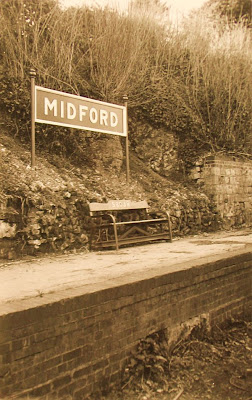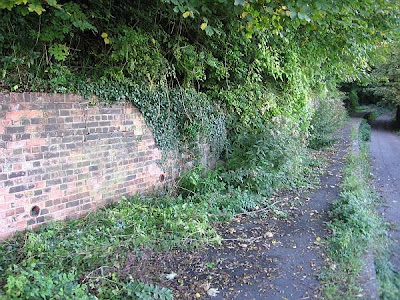


A couple of articles that came in via finance emails over the last two days. Money men are wonderfully unsentimental and usually years ahead of the general public. The rail future message is clearly getting through ...
From MoneyWeek Asia
This week’s email comes from Malaysia. I’ve travelled down here from Singapore. If you hadn’t realised that was possible, you’re not alone. Even some Singaporeans and Malaysians have no idea there’s a rail link between their capitals.There’s a good reason for that. The journey takes seven hours, in carriages that were once quite luxurious but are now shabby. And dining options are limited.Sure, it’s not as bad as third class in India. You’re not squashed in among the chickens. But you may find yourself sharing a seat with a freeloading cockroach.However, on the plus side, you get to see something of Malaysia outside the cities. And it also tells you a great deal about relations between Malaysia and Singapore…
Britain’s parting gift - a traditional railway farce
The railway was built when what are now Malaysia and Singapore were British colonies. After independence in 1963, the two were briefly part of the same federation before parting ways in 1965. However, the railway station and track within Singapore remained Malaysian property. This was held by Malayan Railways (KTMB) on a 999-year lease.
Unsurprisingly, this has caused problems. Space in Singapore is at a premium. So the Singaporean government wanted to develop the prime land occupied by the railway. But agreeing a deal proved difficult. And so the railway has become a popular way for the two sides to needle each other.
For example, Singapore’s extensive metro system doesn’t include a stop near the station. The closest bus stand is directly across from the terminus. But you have to cross a busy carriageway to get to it - and there’s no pedestrian crossing.
Kuala Lumpur’s options for retaliation are more limited. But for many years a provocative “Welcome to Malaysia” sign hung above the door.
The high point of the farce came in 1990. A deal was struck to move the station and redevelop the land jointly. Singapore built a new station and immigration checkpoint at the top of the island. Then Malaysia decided to delay its relocation. But Singapore went ahead anyway in 1998.
So today, you pass through Malaysian immigration before you actually board the train. Then you ride a bit further down the line and get off to pass through the checkpoint out of Singapore. It’s the only place in the world I know of where you supposedly enter one country before leaving another.
Pulling together at last
But if you want to take this unique trip, you’d better do it soon. Earlier this year, the two countries finally agreed a deal to relocate the station from July 2011.
This is good news for more than just railway passengers. It should mark the start of much greater cooperation between Malaysia and Singapore. And that should benefit both countries.
Singapore is wealthy. Land is scarce and wages are getting too high to do much manufacturing work. Malaysia is a middle-income economy that still needs more manufacturing jobs, especially in areas such as Johor Bahru, which borders Singapore.
So it would make sense to relocate factories from Singapore into Malaysia’s Iskandar Development Region, just across the straits. This should be good for everyone involved, similar to Hong Kong firms’ moves into China’s Guangdong province in the 1980s and 1990s.
It’s not just manufacturing. Malaysia also wants to increase skilled service developments in the area, such as healthcare, attracting investment and clients from Singapore. These can benefit from Malaysia’s lower labour costs while allowing workers to move into high-value sectors. This is crucial to keep ahead of competition from countries such as China which have hurt lower-end employment.
The possibilities don’t end there. For example, Singapore is one of the world’s leading financial centres, while Malaysia - where Islam is the main religion - hopes to make Kuala Lumpur the global hub for Islamic finance: the two could clearly be complementary.
More broadly, Southeast Asian countries will need to work together in the years to come to deal with the rise of China and India. The Association of Southeast Asian Nations (ASEAN), long derided as a talking shop, finally seems to be evolving into something more. It has the potential to become a major free trade and investment area. As the two most advanced economies in the region, Malaysia and Singapore will obviously be key players in such a trend.
Malaysia is investing in the future againA trip down the railway also shows you how things are changing in peninsular Malaysia. The network itself is being upgraded. And you also trundle past new roads, residential buildings and other construction projects.
This is encouraging. Malaysia desperately needs investment - in infrastructure and elsewhere - to stay ahead of regional rivals and make the leap to developed status in a decade or two.
The country suffered several years of drift under its previous prime minister, Abdullah Badawi. He was well-meaning and relatively honest by the standards of Malaysian politics, but showed little determination.
But his former deputy Najib Razak, who succeeded him in April 2009, shows more promise. He seems to have a clear idea of what Malaysia needs, plus the determination to push it through.
For example, the latest budget included a RM40bn (£8.2bn) plan to expand Kuala Lumpur’s woeful metro transport system to cover the whole city, along with other infrastructure and skills spending. And moves have been made to attract more foreign companies, especially in areas such as financial services.
Meanwhile, some of the bumiputra rules that discriminate in favour of ethnic Malays and against other races are being relaxed a little. These affirmative action policies were intended to lift the standard of living for poorer Malay groups and had an important purpose at first.
But they also made much of the country feel like second-class citizens, discouraged investment and exacerbated racial divisions. So for the last year or so, Malaysians have been bombarded with the “1Malaysia” campaign, which attempts to smooth over these differences and persuade everyone to work together.
Of course, this is extremely cynical. The same politicians who are now promoting this campaign were happy to pander to racial divisions when that suited the agenda better. The metro is plastered in pro-equality quotes from Abdul Razak, Najib’s father, who as prime minister in the 1970s was responsible for introducing the bumiputra policies in the first place.But it reflects the new reality. As China and India become more important, Malaysia’s ethnic Chinese and Indian populations and their connections could be very handy - but only if they don’t feel rejected by their country. So it’s encouraging to see that top politicians are pragmatic enough to recognise this and change track.
And from today's Money Morning
To the average British rail commuter, the notion of sleek, efficient, high speed trains seems laughable. Just finding a train that can get you from point A to point B at somewhere near the promised time is an achievement. Doing it without bankrupting yourself is another thing altogether. High-speed rail links are a dream that's been promised to the British commuter by various governments for years. Yet it never seems to come true. But the outlook for commuters elsewhere in the world is far more promising. While you were slogging your way in and out of work yesterday, China was unveiling the fastest train line in the world. And this isn't some bold but ultimately doomed 'prestige' project like Concorde. It's merely the latest addition to an already extensive network of high-speed rail links. Indeed, I reckon high speed rail could be one of the most important investment themes of the next few years. Here's why...
The world's fastest train runs between Shanghai Pudong International Airport and the city outskirts. As it glides along the track, LED screens in the carriages show the speed tick up to as much as
431km an hour (that's 268 miles per hour). A return journey costs £7.50. That's less than the price of a peak-time London Underground ticket. By contrast, one of Britain's high-speed trains, the Virgin Pendolino, travels from Birmingham to London at about 200km an hour (or 125 miles per hour). When it comes to high speed rail, China is thinking big. By 2020, all major cities in China will be connected by trains that run at 350km per hour. Beijing is investing $300 billion upfront. The World Bank described the project as "the biggest single planned program of passenger-rail investment there has ever been in one country". The rest of the world is now playing catch up. Billions of dollars are being poured into high speed rail - and just a handful of companies are equipped to scoop it up.
How China took the lead in high speed rail
The Shanghai train is a 'Maglev', short for 'magnetic levitation'. It actually floats just above the track. Magnets propel it forward silently and the lack of friction allows it to reach phenomenal speeds. Ironically, the world's first commercial Maglev ran from Birmingham International to Birmingham airport back in 1984. But the UK let the technology slip through its fingers. The route was dismantled in 1995 and replaced by a bus. Meanwhile, Beijing has eagerly sucked up all the cutting-edge rail technology it can find. When it announced its plans back in 2004, the companies that came forward to bid for the biggest rail contracts in history were a who's who of rail technology: Bombardier (Canada), Siemens (Germany), Alstom (France) and Kawasaki Heavy Industries (Japan). In the competition for contracts, the companies agreed to onerous terms and conditions. Production had to occur in China, and they had to agree to 'technology transfers', effectively helping to set up their own cheap Chinese competitors. Beijing has a word for this acquisitive process: 'digesting'. Six years later, high speed rail companies are now having to compete with the Chinese rivals they created. Two Chinese manufacturers, CSR and CNR, are already among the world's top four train makers, as the chart below shows. These companies are now snapping at each other's heels to land contracts world wide.
We're about to see the biggest expansion of rail since the days of the Wild West. Billions of dollars are being pumped into high-speed rail projects worldwide, from Bologna, to Argentina, to California. It could be one of the most lucrative investment themes of the decade. Why are governments so taken with high speed rail? First off, there's the 'green' vote - 'greenhouse gas' emissions can be up to 90% lower than flying. It makes economic sense too - better transport links mean a more mobile, productive workforce, which makes life cheaper for companies. And rail schemes are also big employers. The Beijing-Shanghai link alone employs 110,000 workers. In the US, $8bn of stimulus funds has been set aside for high speed rail projects. A $2.7bn project in Florida is set to open in 2015, and a Los Angeles-to-San Francisco link costing upwards of $40bn should open in 2020. And on Tuesday 28 September, Amtrak unveiled a $117bn, 30-year vision for a high speed rail line linking the entire East Coast. Political grandstanding by the Republicans may cause problems for some of these projects. But the US is just one of many countries looking at high-speed rail. Here in Britain, construction on a line linking London to the northern cities of Birmingham, Manchester and Leeds is due to start in 2015. And projects are also underway in Spain, Italy, South Korea and India.






































